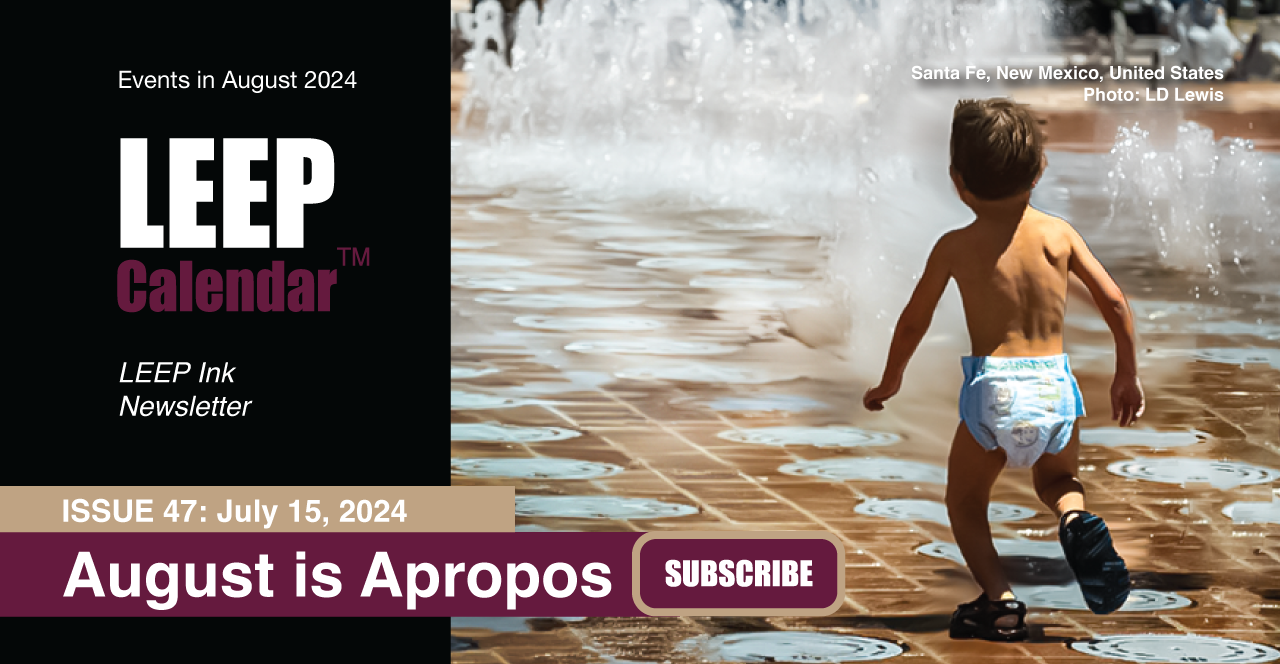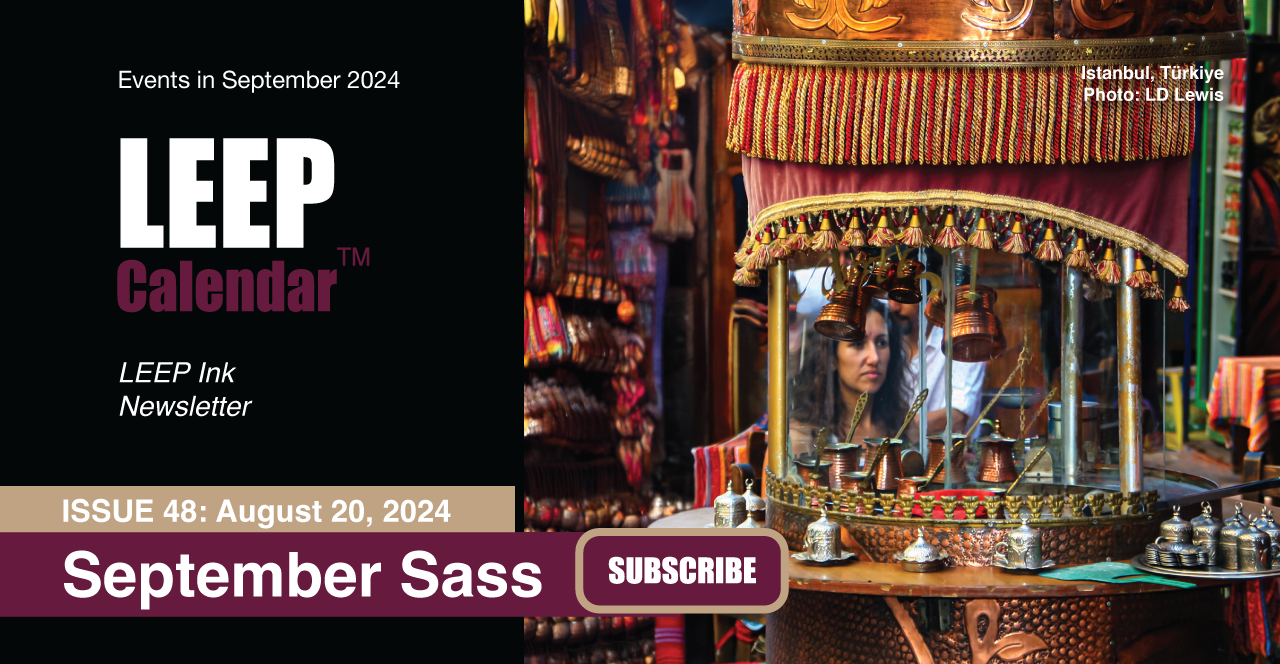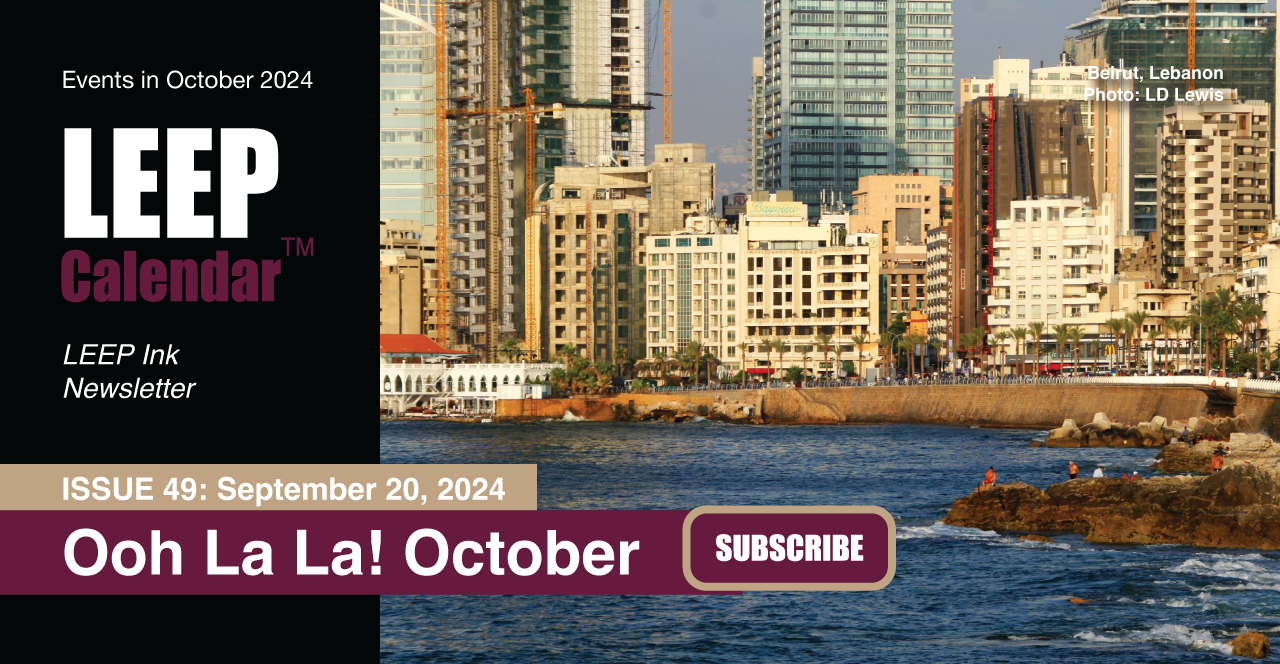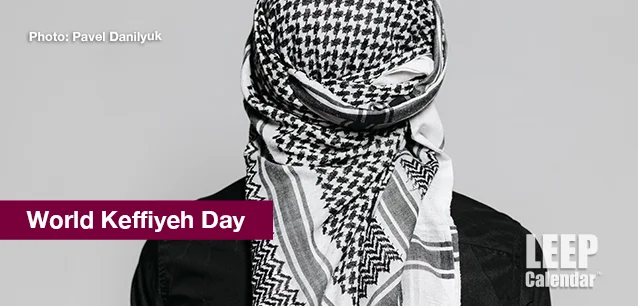 AD
AD
Country
- Africa
- Alcohol, Tobacco & Drugs
- Animals, Fish, Insects & Birds
- Anniversaries
- Australia
- Books
- Brazil & S.America
- Buddhism
Category
- Afghanistan, AF
- Aland Island, AX
- Albania, AL
- Algeria, DZ
- American, Samoa, AS
- Andarra, AD
- Angola, AO
- Anguilla, Al
Event Type
- Daily
- Weekly
- Annual
- Recurring
Duration
- All
- 1 Day
- 2 Day
- 3 Day
- 4 Day
- 5 Day
- 6 Day
Event Type
- Daily
- weekly
- Annual
- Recurring
Event Type
- Daily
- weekly
- Annual
- Recurring
Today is: October 18
Beard Day (No)
Birth of the Bab (1819)
Chocolate Cupcake Day
Fall Festival of Leaves, Ross County (US-OH)
Independence Day Holiday, (AZ)(1991)
Mammography Day, Ntl.
Menopause Day, World
Missouri Day Festival and High School Band Competition (US-MO)
Opossum Day, Ntl. (CA)
Person's Day (CA)(1929)
Saint Luke Feast Day
Squash Day, World
Anti-Poverty Week, (AU)
Baking Week, Ntl. (UK)
Bone and Joint Action Week, Ntl.
Case Management Week, Ntl.
Coffee Week, (UK)
Earth Science Week
Felabration (NG)
Food Bank Week, Ntl.
Food and Drug Interaction Education Week
Foot Health Week (AU)
Healthcare Central Service and Sterile Processing Week
Infection Prevention Week, Intl.
MassKara Festival (PH)
Newspaper Week (JP)
Nutrition Week (AU)
OCD Awareness Week, Intl.
Pet Peeve Week, Ntl.
Recycle Now Week (UK)
Recycle Week, Ntl. (UK)
School Safety Week, Ntl (CA)
Storytelling Festival, Scottish Intl. (UK)
Sukkot (J)
Take Your Medicine Week, America
Urban Wildlife Week, Intl.
Veterans' Health Week (AU)
Wildlife Refuge Week, Ntl.
ADHD Awareness Month
Adopt-a-Dog Month, (AHA)
Adopt-a-Shelter Dog Month
Advertising, Co-op Advertising Awareness Month
Animal Safety and Protection Month, Ntl.
Antidepressant Death Awareness Month
Anxiety and Depression Awareness Month (AU)
Apple Month, Ntl.
Applejack Month
AquaTober
Architecture Month, Archtober
Arts and Humanities Month, Ntl.
Autism Awareness Month (CA)
Bake and Decorate Month, Ntl.
Bat Appreciation Month
Battery Safety Month (Auto)
Bi-national Health Week (US/CA/MX-varies locally)
Big Draw, The
Bilingual Child Month, Celebrating the
Black History Month (UK)
Black Speculative Fiction Month
Blind Month, National Meet the
Blindness Awareness Month
Book Month, Ntl.
Breast Cancer Awareness Month, Ntl.
Bullying Month, Stop, Ntl.
Bullying Prevention Month, Ntl.
Caffeine Addiction Recovery Month
Car Care Month, Ntl. Fall
Caramel Month, Ntl.
Celiac Awareness Month (US)
Cheese Month, American
Chili Month, Ntl.
Chiropractic Health Month, Ntl.
Church Library Month
Church Safety and Security Month, Ntl.
City, Urban October
Class Reunion Month
Clergy Appreciation Month
Co-op Awareness Month
Collegiate Alcohol Awareness Month, Ntl.
Company Culture Month, Global
Computer Learning Month
Contact Lens Safety Month
Cookie Month
Country Ham Month
Country Music Month
Crime Prevention Month, Ntl.
Critical Illness Awareness Month
Cybersecurity Month, Ntl.
Danger Run (US-KY, IN, IL)
Danger Run (US-KY, IN, IL)
Dental Hygiene Month, Ntl.
Depression Education and Awareness Month
Dessert Month, Ntl.
Disability Employment Awareness Month
Diversity Awareness Month, Global
Domestic Violence Awareness Month
Down Syndrome Month, Ntl.
Dyslexia Awareness Month
Eat Better—Eat Together Month
Eczema Awareness Month
Emotional Intelligence Awareness Month
Energy Action Month, Ntl.
Ergonomics Month, Ntl.
Eye Injury Prevention Month
Fair Trade Month
Family History Month
Festival of Penha (BR-RJ)
Filipino American History Month (1587)
Financial Planning Month
Freethought, Month of, Ntl.
Gain the Inside Advantage Month, Ntl.
Gay and Lesbian History Month (1979)
German-American Heritage Month (1683)
Girls Night In (AU)
Go Sober Month (UK)
Golf Month, Australia
Great Cycle Challenge (AU)
Halloween Safety Month
Head Start Awareness Month
Health Literacy Month
Healthy Lung Month
Healthy Workplace Month (CA)
Hearing, Audiology Awareness Month, Ntl.
Hemophilia, Bleeding Disorders Month, Ntl. (AU)
Hog-out Month (US-TX)
Home Eye Safety Month
Indigenous Peoples Month, Ntl. (PH)
Islamic History Month (CA)
Italian-American Heritage Month (1492)
Kartika (H)
Katik (S)
Kitchen and Bath Month, Ntl.
Learning Disabilities Month, Ntl. (CA/US)
Learning and Development Month, Ntl.
Liver Awareness Month, Ntl.
Long Term Care Planning Month
Lupus Awareness Month (UK)
Medical Librarians Month, Ntl.
Medicine Abuse Awareness, Ntl.
Menopause Month, World
Museums and Galleries Month (PH)
Muslim American Heritage Month (US)
National Sausage Month
Non-GMO Month, Ntl.
Organize Your Medical Information Month
Orthodontic Health Month, Ntl.
Pasta Month, Ntl.
Pedestrian Safety Month
Pescatarian Month, Ntl.
Pet Wellness Awareness Month, Ntl.
Pharmacist Month, American
Photographer Appreciation Month
Physical Therapy Month, Ntl.
Pickled Peppers Month
Pink Ribbon Breakfast (AU)
Pit Bull Awareness Month, Ntl.
Pituitary Awareness Month (UK)
Pizza Month, Ntl. (1984)
Polio Awareness Month, (CA/AU)
Polish-American Heritage Month
Popcorn Poppin' Month, Ntl.
Positive Attitude Month
Prenatal-onset GBS Disease Recognition Month
Pretzel Month, Ntl.
Principal's Month, Ntl.
Protect Your Hearing Month, Ntl.
Rabi al-Thani (M)
Reading Group Month, Ntl. (1917)
Rett Syndrome Awareness Month
Riyadh Season 2024 (SA)
Roller Skating Month, Ntl.
STEM Mentoring Month
Sarcastic Awareness Month
School Libraries Month, Intl.
Seafood Month
Seed Gathering Seasons (UK)
Senior's Month (AU-QLD)
Sensory Awareness Month, Ntl.
Shoctober - Defibrillator National Awareness Month (AU)
Spina Bifida Awareness Month, Ntl.
Spinach Lovers Month
Spinal Health Month, Ntl.
Squirrel Awareness and Appreciation Month
Stamp Collecting Month, Ntl
Stop America's Violence Everywhere (SAVE) Month
Substance Abuse Preservation Month, Ntl.
Sudden Infant Death Syndrome (SIDS) Awareness Month
Sunday School Teacher Appreciation Month
Teentober
Tishrei (J)
Turner Prize Exhibition (UK)
U.S.-Mexico Border Health Month
Ultrasound Awareness Month
Unblocktober (UK)
Unblocktober (UK)
Vegetarian Month
Walk To School Month, Intl.
Window Covering Safety Month, Ntl.
Winter Weather Preparedness Weeks (Varies by Location)
Wishbones for Pets (US/CA)
Women's History Month (CA)
Women's Small Business Month
Work and Family Month, Ntl.
Workplace Politics Awareness Month
Youth Justice Action Month, Ntl.
LEEP Calendar
Scroll to explore events active on this date.
LEEP INK FEATURES

August is Appropos
A toddler playing in the fountain at a park in Santa Fe, New Mexico—Photo LD Lewis. In August, we live through the Dog Days of Summer. It's hot and often humid, and those ...

September is Sassy
Can you hear that sigh of relief from parents worldwide? Yes! September marks the return of students to school, a global phenomenon. Preparations for the ACT and SATs begin earnestly for ...

OOH LA LA, October
October is the busiest month for events, with 5% more happening than in May, the second most eventful month. Sailing enthusiasts will be glued to the finals of this year's Am...
About World Keffiyeh Day
Culture & Art , Legal
Middle East/West Asia
Ends: May 11, 2025
DESCRIPTION:
ABOUT WORLD KEFFIYEH DAY
World Keffiyeh Day (May 11) and Nakba Day (May 15) demonstrate solidarity with the Palestinian cause and struggle.
WHAT IS A KEFFIYEH?
A keffiyeh (also known as a kufiya, shemagh, or ghutrah) is a centuries-old traditional Arabian scarf worn by men and women. Its appearance differs slightly depending on the region. Black and white tends to be the color chosen in the Levant (Lebanon, Israel, Palestine, Syria).
Red and white or plain white is more common in the Gulf states and North Africa. Versions in beige, blue, and green can also be found; however, these are more recent incarnations and are not specific to a region.
The keffiyeh's pattern resembles the fishing nets and agricultural lands that have fed generations for thousands of years. The scarf is worn by people of all faiths as protection from the sun, wind and sand.
A SYMBOL OF SOLIDARITY, FREEDOM AND CULTURE
Beginning in the late 19th century, prior to the fall of the Ottoman Empire and through the First World War, the keffiyeh became a popular symbol of solidarity for Arabs struggling against colonialism. With the establishment of Israel in 1948, it became associated with the Palestinian people in their struggle against Israel's brutal colonization and subsequent ethnic cleansing of lands not granted to the new state by the United Nations.
KEFFIYEH ENTERS POPULAR CULTURE
In 1967, Israel swept up the rest of the West Bank, Gaza Strip, Golan Heights and the Sinai Peninsula in what became known as the Six-Day War. In the 1980s, the Sinai returned to Egypt, but as the Israeli vise tightened around the Palestinian society now under its occupation, a rebellion known as the First Intifada ("Intifada" is Arabic for "uprising"—nothing more) erupted. Israel, a nuclear superpower, put it down within a year.
Following the First Intifada, PLO leader Yasser Arafat and his consistent donning of a black and white keffiyeh elevated the scarf to its iconic current symbolism of solidarity, human rights and freedom from occupation within Palestinian and Arab society.
Following the October 7, 2023 events, it became more than a utilitarian garment and a symbol of Arab culture and unity. The keffiyeh emerged as an internationally recognized symbol of social justice, anti-apartheid, and a demonstration of solidarity with oppressed people worldwide.
Political interests profiting from occupation and oppression have attempted to associate the pattern, which dates back centuries, with "terrorism."
CONTEXT: WHAT IS THE NAKBA?
Nakba Day is an annual day mourning the displacement and ethnic cleansing of Palestinians (December 1, 1947 - December 31, 1949) from their land of over 4,000 years, preceding and through the state of Israel's declaration of independence in 1948.
Nakba, "catastrophe" in Arabic, is the name given to the first ethnic cleansing of Palestine. During these two years, Israel chose to use terror and military force to expand the land given to it by the United Nations by 300%. It did so through conquest, terrorism and ethnic cleansing.
During the Nakba, the Palestinian inhabitants of dozens of villages were massacred, and hundreds of Palestinian towns and villages were depopulated and razed. In total, an estimated 18,000 Palestinians were killed, and 750,000 temporarily fled or were forcibly expelled. Their stolen homes, businesses and land were either given to incoming Jewish immigrants or renamed and disappeared under newly planted pine forests and agricultural kibbutzim.
VIDEOS
SUPPORTING DOCUMENTS
Currently, this event does not have supporting documents.
ADDITIONAL IMAGES
Currently, this event does not have supporting images.
Where would you like to go now?
 AD
AD
By using this site. You are agreeing to use of cookies. Learn more in our Privacy Policy
/footer-logo.svg)
LEGAL: Excerpts and links may be used, provided that full and clear attribution is given to Jubilee LLC and LEEPCalendar.com, with appropriate and specific direction to the original content (Page URL). Additional documents, embedded videos and additional image rights retained by their creators and are provided to increase understanding of the event or topic.
Jubilee LLC reserves the right to accept or reject inclusion of events in this calendar. The appearance of an event in LEEP Calendar does not imply endorsement of the event, nor the organization championing the event by Jubilee LLC, its stakeholders, customers or subsidiaries. All dates, contact information, URLs, addresses, and information relating to any event, promotion or holiday are subject to change without notice and should be treated as estimated. Jubilee LLC, our stakeholders, customers and subsidiaries cannot warrant accuracy. Users of this application are solely responsible for verifying actual event date with organizers and additional sources prior to committing resources, financial, human or otherwise.


